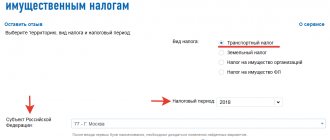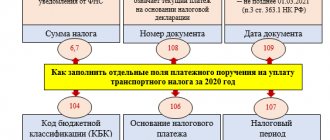Transport tax for organizations from 2021
Transport tax for legal entities refers to regional types of tax payments and is regulated at the federal level (Chapter 28 of the Tax Code), as well as local (regulatory legal acts of the authorities of the constituent entities of the Russian Federation). In accordance with stat. 356 of the Tax Code, regions approve TN rates, terms of payment, benefits and legal grounds for their application. In this case, the restrictions provided for by the Tax Code must be taken into account.
Who exactly is recognized as the taxpayer of this tax? According to stat. 357 of the Tax Code, transport tax for organizations is obligatory for payment if they own vehicles registered in the generally established order. Objects subject to taxation are listed in stat. 358. In particular, these are cars and trucks, motorcycles, buses of various sizes, boats, airplanes and helicopters, and other self-propelled vehicles of land, air and water types (clause 1 of Article 358). The list of non-taxable objects is given in paragraph 2 of the statute. 358.
Timely calculation of transport tax for legal entities is carried out separately for each object registered in the name of the owner (clause 2 of Article 362). Enterprises, unlike individuals, accrue TN on their own, including advance amounts. If the regional authorities do not approve reporting periods in a particular subject of the Russian Federation, the car tax is transferred to the budget in a single amount at the end of the year. Moreover, in accordance with the Tax Code, the tax period is a year (calendar), and the reporting period is quarters (stat. 360).
Will the transport tax for legal entities change in 2021? At the moment, there are no global innovations observed. No one canceled the TN, and the replacement with another fee also did not take place. As before, regional authorities are in charge of administration, approving final rates and payment deadlines. However, some innovations were nevertheless adopted by officials. The changes will affect owners of prestigious expensive cars worth 3-5 million rubles. The size of the increasing coefficient for them is set at a minimum level of 1.1 (stat. 362 of the Tax Code as updated by Law No. 355-FZ of November 27, 2017). Currently, the coefficient is 1.1, 1.3, 1.5.
Another change applies to the tax return form for TN, which was approved by the Federal Tax Service in Order No. ММВ-7-21/668 dated 12/05/16. The document was adopted in 2021, but in practice all legal entities are required to submit a new form when submitting information for 2021. Sections about payments to Platon, lines about the year of manufacture of the vehicle, information about the registration of the object and/or deregistration from state registration have been added to the form.
The current increasing transport tax coefficient
So, paragraph 2 of Art. 362 of the Tax Code of the Russian Federation provides for the following coefficients (for 2018-2019):
- 1.1 - for passenger cars with an average cost of 3 to 5 million rubles. inclusive, from the year of manufacture of which no more than 3 years have passed;
- 2 - for passenger cars with an average cost of 5 to 10 million rubles. inclusive, from the year of manufacture of which no more than 5 years have passed;
- 3 - for passenger cars with an average cost of 10 to 15 million rubles. inclusive, from the year of manufacture of which no more than 10 years have passed, as well as passenger cars with an average cost of more than 15 million rubles, from the year of manufacture of which no more than 20 years have passed.
The procedure for calculating the average cost is determined by the Ministry of Industry and Trade of Russia. He also posts on his website on the Internet a list of passenger cars with an average cost of 3 million rubles, the tax on which must be calculated with an increasing coefficient. You can track updates to the list of the Ministry of Industry and Trade on the department’s website.
The age of the car is determined taking into account the year of its manufacture (letter of the Ministry of Finance of Russia dated January 23, 2015 No. 03-05-05-04/1817).
Note that it is important to know the size of the increasing coefficient only for tax payers - organizations, since they calculate the tax independently (clause 1 of Article 362 of the Tax Code of the Russian Federation). For “physics” the coefficient will be applied by the inspectorate.
For information on how to fill out a return for 2021, read the material “Filling out a transport tax return for 2018.”
For more information on the procedure for calculating transport tax, read the article “How to calculate transport tax on a car?”.
If an expensive car is registered to your company, before calculating the transport tax, check:
- Is your car included in the list posted on the website of the Ministry of Industry and Trade? Use only the current list (it is updated annually).
- Does the period of use of the car exceed the period established in the Tax Code of the Russian Federation for the purposes of applying the increasing coefficient? When calculating the period, it is necessary to start with the year the car was launched from the assembly line and end with the year for which the tax is paid (letter of the Federal Tax Service of Russia dated March 2, 2015 No. BS-4-11 / [email protected] ).
If at least one of the conditions is not met, the increasing factor is not applied.
To find out whether an increasing coefficient is applied to the tax if the car is not listed in the list published by the Ministry of Industry and Trade, read the material “How to pay transport tax if an expensive car is not on the list of the Ministry of Industry and Trade?”
TN = TPop × Kp,
where TPop is the amount of transport tax calculated according to the general rules (the product of the tax base by the tax rate and the vehicle ownership coefficient);
Kp - increasing coefficient.
It is also necessary to pay tax taking into account the increasing coefficient in cases where the description of the model (version) for the corresponding brand of passenger car in the list of the Ministry of Industry and Trade contains less or more information compared to information from the State Traffic Safety Inspectorate (letter of the Federal Tax Service dated July 18, 2017 No. BS-4-21 / [email protected] ).
In this connection, many questions arise about how to calculate the transport tax coefficient Kv in 2021. Situation 1 When a car is assigned to a separate unit for an incomplete period of the tax reporting period, and came here from the parent organization, the calculation and payment of tax must be made from the month following the registration of the vehicle. Situation 2 Suppose transport was transferred from one division to another within the same enterprise.
Changes depend:
- from the purchase price,
- Year of release.
The maximum figure applies to cars costing more than 15,000,000 (Fifteen million) Russian rubles, and no older than 20 years from the date of release from production to the sales market. Every year, the list of vehicles is updated on the website of the Ministry of Industry and Trade of the Russian Federation, no later than the first day of March month.
Since legal entities are required to make the first advance payment of taxes using a multiplying factor. Accrual and payment are made quarterly. Details for paying transport tax Example of a coefficient for calculating transport tax: A vehicle was purchased in June 2021. The total useful life was 7 months. Conditionally, let’s assume that the increasing coefficient for 2021 will be 1.2.
Increasing coefficients when calculating transport tax for passenger cars, given in paragraph 2 of Art. 362 of the Tax Code of the Russian Federation are:
- 1.1 - for a car with an average cost of 3–5 million rubles. inclusive, from the year of issue of which 2 to 3 years have passed;
- 1.3 - for cars of the same cost, from the year of manufacture of which 1 to 2 years have passed;
- 1.5 - for a car with an average cost of 3–5 million rubles. inclusive, from the year of manufacture of which no more than 1 year has passed.
- 2 - for cars with an average cost of 5–10 million rubles. inclusive, if their age is not more than 5 years.
- 3 - for a car worth 10–15 million rubles. inclusive with an age of no more than 10 years, as well as those valued at more than 15 million rubles. and are no more than 20 years old.
The age of the car also includes the year it left the factory assembly line.
An important criterion for the mandatory application of the increasing coefficient for transport tax in 2021 is the average cost of the object. Its methodology is approved by the Ministry of Industry and Trade of the Russian Federation. In addition, his responsibilities include identifying the appropriate vehicles eligible for the coefficient. This information for all previous periods is posted on the department’s online resource.
IT SHOULD BE NOTED! All the information provided regarding the choice of tax coefficient values is needed only by companies, since they themselves are responsible for calculating and paying taxes. For citizens, this information does not matter, since they pay tax based on notifications with a ready-made amount.
Transport tax - tariffs
The final tariff rates are adopted by regional authorities, taking into account the maximum/minimum restrictions under stat. 361. An increase in tariffs for certain types of vehicles in the Leningrad region has already been approved. and St. Petersburg, Ulyanovsk region, Arkhangelsk, Kirov and Kostroma. To know exactly how to calculate transport tax for legal entities, you need to clarify the interest rate for vehicles registered to the company. In this case, information is taken from the current version of the regional law.
The tax base
It is worth remembering that the taxpayer is the owner of the vehicle, an individual or an organization, and the object of taxation is always the vehicle itself. What is the tax base?
The concept of the tax base gives the real tax code depending on the type of vehicle itself.
It is defined this way:
- if the vehicle has an engine, as such, then the tax base is calculated in horsepower. Although in the world measurement system the concept of “horsepower” is already officially considered obsolete, and the kW unit is used almost throughout the world, both units are used in the Russian Federation. And this is stated in the passport and vehicle certificate;
- if the transport moves on water and is considered towed, non-self-propelled, then the tax base will be measured in register tons as gross tonnage;
- if the air transport vehicle has a jet engine, then the tax base is calculated as the thrust of the jet engine;
- if transport moving by water and air does not fit one of the above types, then the tax base will be measured in units.
Thus, we can say that the tax base is a unit of measurement of vehicle power.
Transport tax for legal entities directly depends on the tax base.
Where to pay transport tax for legal entities
Transfer of TN based on the results of the year and quarters (in case of approval of reporting periods in a separate subject of the Russian Federation) is carried out to the regional budget at the address of the vehicle location (clause 1 of Article 363). The last address for all means of transportation, except for water ones, is the address of the location of the enterprise or OP (Article 83). If an organization is obligated to pay advances under the Taxpayer Agreement, such amounts reduce the total tax for the year.
The timing of the transfer of transport fees is regulated by the regions of the Russian Federation. In this case, the final payment date cannot be approved in the subject earlier than February 1 of the next year (clause 1 of Article 363). Here is a link to the stat. 363.1, which discusses the procedure for submitting a declaration. Accordingly, in the region, the deadline for transferring TN should not be set earlier than the date of filing the declaration, that is, earlier than February 1 (clause 3 of Article 363.1).
How to apply in 2021
Until the beginning of this year, the following options for the increasing coefficient were in force on the territory of the Russian Federation (based on the second paragraph of Article 362 of the Tax Code of the Russian Federation).
In this case, the period begins to be calculated from the moment of release of the vehicle:
- up to 1 year - 1.5;
- from 1 to 2 years - 1.3;
- from 2 to 3 years - 1.1.
Starting from the first day of the current year, on the basis of Federal Law No. 335-FZ, the calculation of transport tax on any expensive car will be carried out using only the smallest increasing factor of 1.1. According to the above-mentioned legislative act, the use of the other two increasing coefficients is cancelled.
However, it should be noted that we are talking about cars costing from three to five million rubles. But the list of such models, the average price of which is in the designated range, can be found on the main page of the official Internet resource of the Ministry of Industry and Trade. This list is updated no later than the first day of the first spring month.
Transport tax for legal entities – payment deadlines in 2018
As a rule, the deadlines for transferring TN for reporting periods are approved before the last day of the next calendar month. For example, in the Rostov region. advances for the 1st, 2nd and 3rd quarters must be paid before 05/03/18, 07/31/18, 10/31/18. Moreover, if the last date of the month falls on a weekend or official holiday, the payment date is shifted to the first working day.
The final payment for TN for 2021 must be made by legal entities no earlier than 02/01/18. The deadlines adopted by the regional authorities are mandatory for all taxpayers. In case of violation, penalties are charged on the amount of arrears in accordance with the requirements of tax legislation for each day of delay. How is transport tax calculated for legal entities? More on this below.
Calculation of transport tax for legal entities
The procedure for calculating TN and advances is defined in stat. 362 NK. For the calculation, indicators of the tax base of the transport facility and the current rate in the region are taken. Additionally, the values of the increasing coefficient and the coefficient of actual vehicle ownership for the tax period are taken into account. The general calculation formula is as follows:
TN = NB x St in % x PovK x FactK, where:
TN - transport tax,
NB – facility power in liters. With. (for auto),
St. in % - the rate for the object in %, valid in the region,
PovK - increasing coefficient for premium cars according to clause 2 of the stat. 362,
FactK – coefficient of actual vehicle ownership for the tax period. Calculated according to the rules of clause 3 of stat. 362.
If an enterprise has several vehicles, the tax is determined separately for each. The results of the calculations are presented to the Federal Tax Service at the place of registration of the car owner in the form of a declaration for the tax period, that is, the calendar year.
Transport tax benefits in Moscow
Before considering the list of citizens and organizations entitled to partial or complete exemption from the transfer of transport tax amounts, let’s figure out which transport is not subject to this tax in any case:
- ships entered in the Russian International Register of Ships;
- transport involved in freight and passenger transportation (across the river or sea, as well as by air);
- offshore drilling vessels, platforms (floating and stationary);
- airplanes/helicopters operated by medical or sanitary services;
- machines used in agriculture for raising livestock or growing crops;
- rowing boats;
- bicycles, scooters, scooters, etc.
| Legal entities entitled to transport tax benefits | A comment |
| Companies engaged in passenger transportation by public urban transport | Taxi services are not included in this list |
| Legal entities that are residents of the Zelenograd SEZ are exempt from tax on vehicles registered in this zone | The benefit is valid for 5 years, starting from the month of vehicle registration |
| Categories of individuals exempt from transport tax | A comment |
| Heroes of the USSR, Russian Federation | one vehicle, except water, air transport, snowmobiles and motor sleighs |
| Awarded the Order of Glory | |
| Veterans and disabled people of the Second World War and military operations | |
| Former juvenile prisoners of the Nazis during the Second World War | |
| Citizens with disabilities of 1st and 2nd groups | |
| Parent (guardian, trustee) of a disabled minor | |
| Parent (adoptive parent) in a family with 3 or more children | |
| Guardian of a disabled child | |
| Participants in tests of (thermo)nuclear weapons, accident liquidators, testers of nuclear installations, survivors of radiation sickness | |
| Owners of passenger cars up to 70 hp. | |
| Victims of radiation |
Does the individual entrepreneur pay transport tax?
Often, in their business activities, businessmen use their own transport. In this case, who is obliged to pay the TN state – an entrepreneur or a citizen? To understand the issue, you need to carefully study the registration documents for the object. Since when registering a car, the certificate indicates an individual and not an individual entrepreneur, an ordinary person also becomes a taxpayer. Consequently, the entrepreneur pays property taxes, including transport and land taxes, on behalf of the citizen, without indicating the legal status of the individual entrepreneur.
Conclusion - we looked at how transport tax is paid by legal entities in accordance with legal requirements. To remain a bona fide taxpayer, an organization must independently calculate and pay the car tax according to the rates and deadlines accepted in the region. In case of violations of regulations, administrative and tax penalties may be applied to the enterprise.











